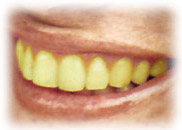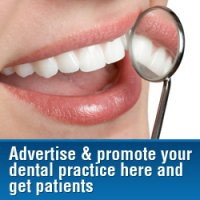
Yellow Teeth
Yellow or Stained Teeth is a very common dental problem that makes a lot of people to feel uncomfortable when they have to talk or smile, due to the color of their teeth. The acquisition of colored substances onto the tooth pellicle is the main cause of yellow teeth that have lost their natural white color. Discolored teeth may require teeth whitening or other cosmetic dental treatment.
White Teeth • How white are our natural teeth?
Human teeth naturally vary in color. Not all people are lucky to have a bright white as the natural color of their teeth. Slightly yellow teeth is normal for most people. Tooth enamel is more or less translucent, so it is the underlying dentin's color that actually determines the tooth color. Normal variations in dentin structure can affect the color of the reflected light, resulting in not perfectly white teeth.
Types of Teeth Stains
The main cause of yellow, stained or discolored teeth is the acquisition of colored substances on or in the tooth. Tooth discoloration may be classified into three main categories:
- Extrinsic tooth discoloration — This occurs when the outer layer of the tooth (the enamel) is stained as by some drinks or foods or by smoking. These external stains can usually be removed through the use of non-bleaching whitening products such as whitening toothpastes that contain abrasive ingredients which help remove surface stains. A thorough dental cleaning by a dentist or hygienist will also remove most of the extrinsic tooth stains.
- Intrinsic tooth discoloration — This is when the inner structure of the tooth (the dentin) darkens or gets a yellow color. Fluorosis or tetracycline stains are examples of common intrinsic stains. Intrinsic stains are best removed through the use of whitening products that can bleach the tooth and change the natural tooth color. Tooth bleaching or dental veneers may also be required for extrinsicly stained teeth if the stains have remained on the teeth for a long period of time allowing them to penetrate to the inner tooth structures.
- Age-related discoloration is usually a combination of extrinsic and intrinsic factors. Yellowing teeth are a common symptom of aging. Their mineral structure changes becoming less porous and making teeth to appear darker. The enamel that covers the teeth gets thinner with age, allowing the underlying layer of yellowish dentin to show through. The continuous accumulation of extrinsic stains also contributes to the natural yellowing of the teeth over time.
Why are my Teeth Yellow? • What causes yellow, stained teeth?
Yellow teeth or dark stained teeth, that have lost their natural white color and need teeth whitening, may be the result of many different reasons. Tooth stains can be categorized as either extrinsic (external) or intrinsic (internal). The success of a tooth whitening treatment depends on choosing the proper whitening method per case, based on the type of stains that cause the tooth discoloration.
Extrinsic tooth stains
- Colored organic compounds from some foods and drinks - tea, coffee, red wine, blueberries, curry and other - are absorbed on teeth enamel, resulting in yellow teeth. Other foods containing chlorophyll may result in green stains on teeth.
- Common dental restorative materials, as the amalgam in silver-colored fillings, may cause discolored teeth by making adjacent areas of teeth black or gray.
- Prescribed antiseptic mouthwashes containing chlorhexidine are associated with causing yellow-brown stains on teeth. Repeated use of stannous fluoride can result in light brown or yellowish teeth stains. Iodine-containing solution medications may also cause similar teeth stains.
- Metallic stains can be caused by metallic salts, such as in iron supplements.
- Other habits as smoking or chewing tobacco are also responsible for stained teeth, creating brown to black stains on the tooth surface. Yellowing of teeth is common among smokers.
- Accumulation of dental plaque and tartar may alter the natural appearance of the tooth and lead to yellow teeth.
Intrinsic tooth stains
- Systemic disorders (as alkaptonuria, erythropoietic porphyria, hyperbilirubinemia etc.) are also causes of stained teeth. Enamel hypoplasia causes tooth discoloration and pitting of the enamel. In rare cases, children with dentinogenesis imperfecta are born with gray, amber or purple discolorations.
- In fluorosis, chalky white spots or brown marks on teeth are caused by excessive fluoride intake (tooth whitening does not actually remove the white spots but lightens the background so they are less noticeable).
- Trauma may cause tooth discoloration by allowing hemosiderin to enter to dentinal tubules. Trauma may change a tooth to a pink, yellow, or dark gray color. Chips or other injuries that damage the pulp of a tooth can also cause discoloration and yellow teeth.
- Some medications, such as the antibiotics tetracycline and minocycline, may become incorporated into the structure of a tooth, causing intrinsic staining of the teeth with a brown-gray color. Use of tetracycline should be avoided during the period of tooth formation, from 4th month of pregnancy until 7 years of age to prevent tooth discoloration.
- After root canal treatment, a tooth may start to darken, especially if the pulp chamber area is not thoroughly cleaned from dead or infected pulp tissue.
 You must always get your dentist's advice before using any tooth whitening product to improve the appearance of stained or yellow teeth, because improper use of bleaching products can seriously damage the tooth enamel.
You must always get your dentist's advice before using any tooth whitening product to improve the appearance of stained or yellow teeth, because improper use of bleaching products can seriously damage the tooth enamel.
![]() The cost involved with dental treatments can be significant and many patients may not afford it if they are not covered by their dental insurance.
Learn how to choose a dental insurance plan that will provide the best dental treatment to you and your family.
The cost involved with dental treatments can be significant and many patients may not afford it if they are not covered by their dental insurance.
Learn how to choose a dental insurance plan that will provide the best dental treatment to you and your family.



